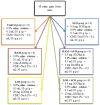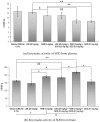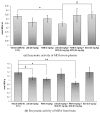The Impact of Some Modulators of the Renin-Angiotensin System on the Scopolamine-Induced Memory Loss Mice Model
- PMID: 37626567
- PMCID: PMC10452197
- DOI: 10.3390/brainsci13081211
The Impact of Some Modulators of the Renin-Angiotensin System on the Scopolamine-Induced Memory Loss Mice Model
Abstract
As some of the renin-angiotensin-aldosterone system (RAAS)-dependent mechanisms underlying the cognitive performance modulation could include oxidative balance alterations, in this study we aimed to describe some of the potential interactions between RAAS modulators (Losartan and Ramipril) and oxidative stress in a typical model of memory impairment. In this study, 48 white male Swiss mice were divided into six groups and received RAAS modulators (oral administration Ramipril 4 mg/kg, Losartan 20 mg/kg) and a muscarinic receptors inhibitor (intraperitoneal injection scopolamine, 0.5 mg/kg) for 8 consecutive days. Then, 24 h after the last administration, the animals were euthanized and whole blood and brain tissues were collected. Biological samples were then processed, and biochemical analysis was carried out to assess superoxide dismutase and glutathione activities and malondialdehyde concentrations. In the present experimental conditions, we showed that RAAS modulation via the angiotensin-converting enzyme inhibition (Ramipril) and via the angiotensin II receptor blockage (Losartan) chronic treatments could lead to oxidative stress modulation in a non-selective muscarinic receptors blocker (scopolamine) animal model. Our results showed that Losartan could exhibit a significant systemic antioxidant potential partly preventing the negative oxidative effects of scopolamine and a brain antioxidant potential, mainly by inhibiting the oxidative-stress-mediated cellular damage and apoptosis. Ramipril could also minimize the oxidative-mediated damage to the lipid components of brain tissue resulting from scopolamine administration. Both blood serum and brain changes in oxidative stress status were observed following 8-day treatments with Ramipril, Losartan, scopolamine, and combinations. While the serum oxidative stress modulation observed in this study could suggest the potential effect of RAAS modulation and scopolamine administration on the circulatory system, blood vessels endothelia, and arterial tension modulation, the observed brain tissues oxidative stress modulation could lead to important information on the complex interaction between renin-angiotensin and cholinergic systems.
Keywords: Losartan; RAAS; Ramipril; antioxidant effect; blood serum; brain; cognitive functions; mice model; oxidative stress; scopolamine.
Conflict of interest statement
The authors declare no conflict of interest, except for the mentioned project.
Figures






Similar articles
-
A Comparative Study on the Memory-Enhancing Actions of Oral Renin-Angiotensin System Altering Drugs in Scopolamine-Treated Mice.Am J Alzheimers Dis Other Demen. 2019 Aug;34(5):329-336. doi: 10.1177/1533317519847042. Epub 2019 May 19. Am J Alzheimers Dis Other Demen. 2019. PMID: 31106575 Free PMC article.
-
Therapeutic potential of ramipril, losartan, and spironolactone against sepsis-associated liver tissue injury induced by cecal ligation and puncture in rats.Eur Rev Med Pharmacol Sci. 2024 Mar;28(5):1821-1836. doi: 10.26355/eurrev_202403_35596. Eur Rev Med Pharmacol Sci. 2024. PMID: 38497865
-
No evidence for involvement of angiotensin II in spatial learning in water maze in rats.Behav Brain Res. 1996 Nov;81(1-2):199-205. doi: 10.1016/s0166-4328(96)00062-9. Behav Brain Res. 1996. PMID: 8950017
-
Angiotensin II reactivation and aldosterone escape phenomena in renin-angiotensin-aldosterone system blockade: is oral renin inhibition the solution?Expert Opin Pharmacother. 2007 Apr;8(5):529-35. doi: 10.1517/14656566.8.5.529. Expert Opin Pharmacother. 2007. PMID: 17376010 Review.
-
Modulation of glucose metabolism by the renin-angiotensin-aldosterone system.Am J Physiol Endocrinol Metab. 2015 Mar 15;308(6):E435-49. doi: 10.1152/ajpendo.00391.2014. Epub 2015 Jan 6. Am J Physiol Endocrinol Metab. 2015. PMID: 25564475 Review.
References
-
- Ababei D.C., Lefter R., Ciobica A., Antioh I., Barbu R.M., Arcan O.D., Chiriac S.B., Zbârcea C., Bild W., Bild V. Effects of Renin-Angiotensin System Blockade on Anxiety and Memory in Mice. Farmacia. 2017;65:381–389.
LinkOut - more resources
Full Text Sources
Research Materials

